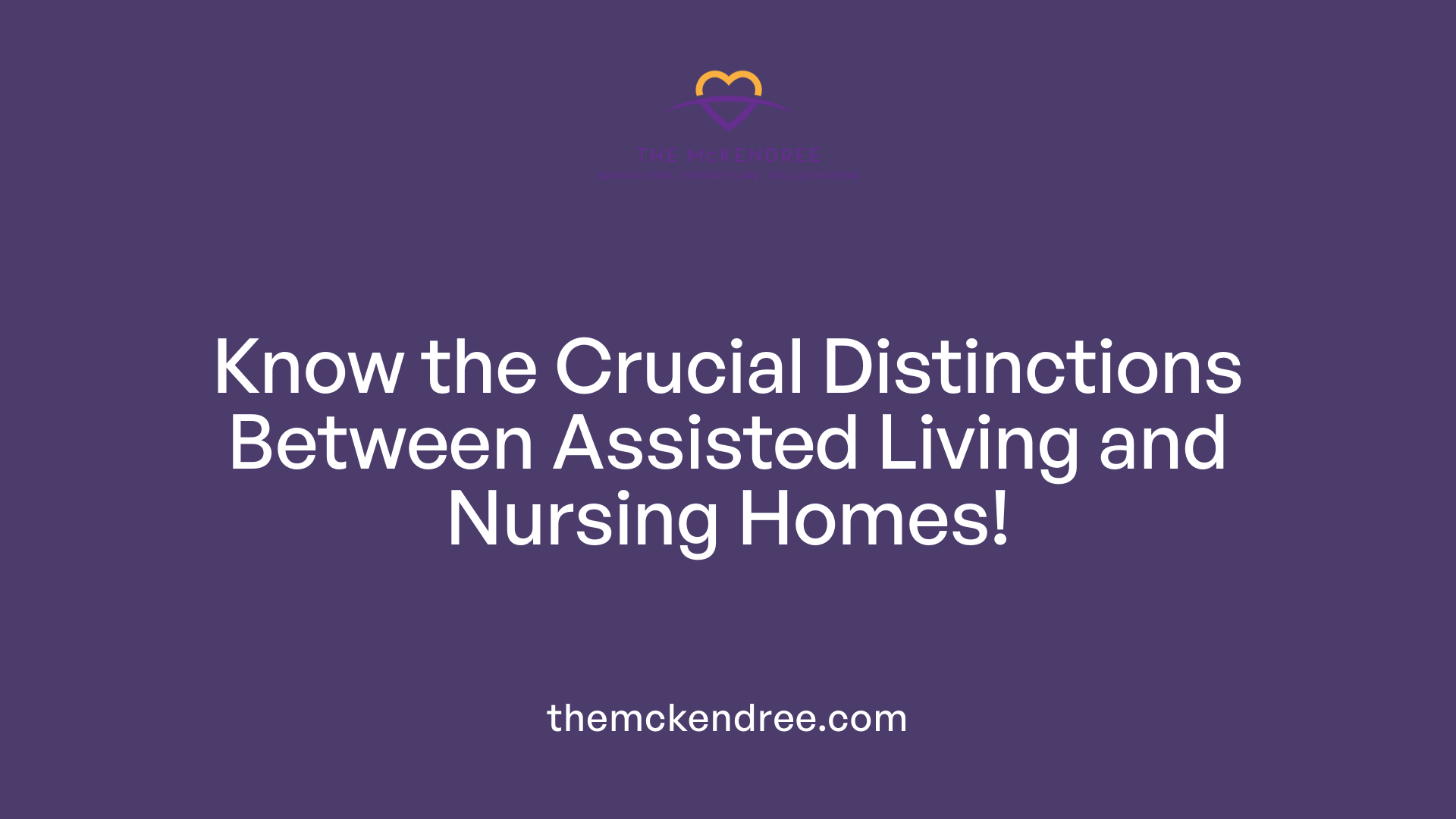The Difference Between Independent Living and Assisted Living

Understanding Senior Living Options
As seniors consider housing options that cater to their lifestyle and health needs, understanding the distinctions between independent living and assisted living becomes crucial. Both living arrangements offer unique benefits and are tailored to specific levels of independence, service needs, and financial considerations. This narrative explores two primary senior living options, detailing their characteristics, services, and financial aspects to aid seniors and their families in making informed decisions.
Independent vs. Assisted Living: Key Facts
- Independent Living: Designed for active seniors aged 55+ seeking community without health assistance.
- Assisted Living: Provides 24/7 assistance with daily activities for those needing help with ADLs.
- Monthly costs for Independent Living average $3,100, while Assisted Living costs around $4,995.
- Independent living promotes social interaction through planned community activities and events.
- Assisted living focuses on personalized care plans to meet individual health needs.
- Independent living communities often include features like transportation and housekeeping.
- Residents of assisted living receive help with medication management, bathing, and grooming.
- Seniors may transition to assisted living if they show increased health issues or need more support.
- Medicaid may cover costs for assisted living but typically does not for independent living.
- Nursing homes provide comprehensive medical care, unlike assisted living that focuses on independence.
1. Independent Living: An Active Lifestyle with Minimal Assistance

What is independent living for seniors?
Independent living for seniors refers to housing arrangements specifically designed for older adults, generally aged 55 and over, who aim to maintain their independence while enjoying a community lifestyle. These communities offer various types of accommodation, such as apartments or cottages, equipped with accessibility features and often emphasizing convenience in daily living.
Independent living communities prioritize providing an environment that fosters social interaction and engagement. This is accomplished through a rich social calendar that often features planned activities, cultural events, and wellness programs, all designed to enhance the quality of life for residents. Services like transportation, housekeeping, and meal plans are typically offered, allowing residents to focus on enjoying their life rather than being bogged down by household chores. Although independent living does not include direct medical care, it provides peace of mind with safety features such as emergency response systems and routine maintenance support.
What services and amenities are offered in independent living?
Independent living communities generally include a variety of services and amenities aimed at enhancing the residents’ experience:
| Amenities/Services | Description |
|---|---|
| Housing | Options include private apartments, cottages, or townhouses designed for seniors. |
| Meal Services | Flexible dining options may include communal dining experiences or allow residents to prepare their own meals with fully-equipped kitchens. |
| Housekeeping | Regular cleaning and maintenance services to alleviate household responsibilities. |
| Transportation Services | Scheduled transport for outings or medical appointments, encouraging residents to stay active and involved. |
| Social Activities | A wide range of wellness programs, interest-based events, and group outings to promote socialization. |
| Safety Features | Emergency response systems, security personnel, and secure entry points to ensure resident safety. |
These amenities create a supportive environment that meets the various needs of the seniors while focusing on fostering a community atmosphere.
What cost considerations come with independent living?
Cost can be a significant factor when considering independent living. The median monthly cost in 2024 is approximately $3,100, translating to about $36,780 per year. These costs generally cover rent and basic services but can vary significantly based on location, size, and amenities offered. Unlike assisted living, independent living facilities usually do not receive funding or reimbursement through Medicare or Medicaid, which may limit financial assistance options.
In independent living, residents may find it necessary to consider additional expenses related to optional services, such as meal plans or special programs. Moreover, many communities require a one-time entrance fee that covers amenities or upgrades in living options, which can impact the upfront investment needed.
Who is independent living suitable for?
Independent living is best suited for active older adults who are relatively healthy and able to live without assistance for daily activities, such as bathing, cooking, and general housekeeping. This arrangement also appeals to those seeking engagement in a vibrant community without the burden of maintaining a private home.
Ideal candidates for independent living are individuals who:
- Desire to live independently with minimal assistance.
- Seek a social environment with peers and organized activities.
- Wish to alleviate the daily responsibilities associated with home maintenance.
- Value security features that provide peace of mind while enjoying their lifestyle.
This living arrangement allows for future transitions to more supportive care as needed, ensuring residents can remain within a familiar community as their health or needs change.
2. Assisted Living: Personalized Support and Care

What is Assisted Living?
Assisted living is a type of senior housing designed for older adults who require assistance with activities of daily living (ADLs) while still wishing to maintain a degree of independence. Facilities typically offer a range of services that support residents in their daily routines, which may include help with bathing, dressing, grooming, and medication management.
Living arrangements in assisted living communities often resemble apartment-style living, with common areas for dining, social activities, and recreational opportunities.
What Healthcare and Personal Support Services are Offered?
Assisted living facilities provide a variety of healthcare and personal support services tailored to the needs of their residents. Key services typically include:
| Service | Description | Availability |
|---|---|---|
| ADL Assistance | Help with bathing, dressing, grooming, and meal preparation. | 24/7 support |
| Medication Management | Oversight and assistance with medications. | Regular check-ins |
| Meal Services | Three meals a day, often tailored to dietary needs. | Included in fees |
| Housekeeping | Regular cleaning and maintenance of living quarters. | Regularly scheduled |
| Personalized Care Plans | Individualized plans based on each resident's healthcare needs. | Regular updates by staff |
These services aim to enhance the residents' quality of life, allowing them to engage in social activities while receiving the necessary support to manage their health.
What are the Cost Considerations?
The median cost for assisted living in 2024 is approximately $4,995 per month, reflecting the level of care provided. This price is significantly higher than the median cost of independent living, which averages around $3,100 per month. The costs for assisted living generally include rent, meals, utilities, and personal care, though additional fees may be charged for specialized services.
Assisted living costs can sometimes be partially covered through long-term care insurance or Medicaid for qualifying individuals, making it a more viable option for those with financial constraints compared to independent living, which typically does not offer such coverage.
Who is Assisted Living Suitable For?
Assisted living is particularly suitable for older adults who are facing challenges with daily tasks due to health issues but do not require the full-time medical care provided in nursing homes. This living arrangement allows seniors to maintain a level of independence while receiving necessary support, contributing to an overall enhanced lifestyle.
Individuals who thrive in assisted living typically share these characteristics:
- Require assistance with activities like bathing, grooming, and meal preparation.
- Have chronic health conditions that necessitate regular oversight.
- Seek a supportive community with access to healthcare professionals.
How Does Assisted Living Compare to Independent Living and Nursing Homes?
It's essential to understand how assisted living distinguishes itself from both independent living and nursing homes:
- Independent Living: Focuses on providing a maintenance-free lifestyle for healthy seniors who do not need assistance with ADLs but desire community activities and social interaction.
- Assisted Living: Bridges the gap by offering more comprehensive support for daily activities while also promoting independence.
- Nursing Homes: Provide around-the-clock medical care for seniors with significant health needs, offering intensive medical support that assisted living communities do not.
These differences help seniors and their families make informed decisions based on their specific needs and preferences, considering options like Continuing Care Retirement Communities (CCRCs) for those who might require varying levels of care as their health changes over time.
Differences & Transitions in Senior Living

What is the difference between independent living and assisted living?
Independent living and assisted living cater to different needs of seniors based on their levels of independence.
Independent Living (IL): This option is designed for active seniors who are generally capable of taking care of themselves. Residents enjoy maintenance-free living with amenities such as social events, transportation, and recreational activities, without the support of healthcare services.
Assisted Living (AL): In contrast, assisted living facilities offer a higher level of support for seniors who require help with daily tasks like bathing, dressing, and medication management. These communities feature personalized care plans and staff available 24/7, ensuring that residents receive necessary assistance while promoting their independence as much as possible.
In terms of costs, independent living typically averages around $3,100 monthly, while assisted living is higher, averaging about $4,995 per month. Thus, the primary distinction lies in the type of support offered—independent living emphasizes autonomy, while assisted living focuses on providing necessary assistance for daily living activities.
What factors determine when a senior should move from independent living to assisted living?
Deciding when to transition from independent living to assisted living is a critical choice that involves various considerations. Key factors include:
Need for Assistance: If a senior starts struggling with activities of daily living (ADLs) like bathing, grooming, or medication management, it may be time to consider a move.
Signs of Declining Health: Weight loss, neglect of personal hygiene, or increased forgetfulness can indicate that assistance is necessary.
Socialization Opportunities: Assisted living also fosters better socialization, which can help alleviate feelings of loneliness and support caregiver mental health.
According to recent research, about 13.4% of adults aged 75 and older require personal care assistance. Having open, respectful conversations about the evolving needs of elderly loved ones is crucial, allowing for a smoother transition when the time arrives.
Overall, assessing both health and social dynamics facilitates understanding whether the support offered by assisted living becomes essential for well-being.
Financial Aspects of Senior Living

How can the costs of independent living and assisted living vary?
The costs associated with independent living and assisted living can vary significantly, primarily due to the level of services provided in each setting. As of 2024, the median monthly cost of assisted living is approximately $4,995, reflecting its comprehensive support services, including assistance with daily activities and ongoing medical oversight. In contrast, independent living costs about $3,100 per month. This lower cost is a result of independent living being tailored for seniors who are self-sufficient and do not require regular assistance with daily tasks.
Assisted living communities focus on delivering individualized care, which accounts for their higher price point. Residents in these facilities often receive help with activities like bathing, dressing, cooking, and medication management, thus justifying the additional expenses. On the other hand, independent living residents typically manage their day-to-day activities without additional care, leading to lower overall costs.
What are the payment options and insurance coverage for these living arrangements?
Payment options differ significantly between independent living and assisted living. Independence is generally funded through private pay, meaning residents typically pay out-of-pocket for their living expenses. In contrast, assisted living may have multiple payment options available. Residents might benefit from long-term care insurance that covers some costs, and Medicaid can assist low-income seniors with specific services, making it a more financially accessible choice for those needing ongoing support.
Understanding the financial obligations involved is crucial for seniors and their families when selecting the appropriate living arrangement. With varying costs and financing methods, individuals can make informed decisions based on their health and financial circumstances.
Understanding Assisted Living vs. Nursing Homes

How does assisted living differ from a nursing home?
Assisted living and nursing homes are designed to meet different needs of seniors. Assisted living communities focus on maintaining independence while offering help with activities of daily living (ADLs) like bathing, grooming, and medication management for those who may need some support but are largely self-sufficient.
On the other hand, nursing homes are tailored for individuals requiring comprehensive healthcare services. They provide 24/7 skilled nursing care and are suited for residents with complex medical conditions that necessitate more extensive support.
Comparing care levels and living conditions
Residents of assisted living experience a balance of independence and assistance. The environment is more homelike, promoting social interaction and community activities. In contrast, nursing homes often have a more clinical atmosphere, prioritizing medical care over social engagement.
A significant point of distinction is cost; assisted living is generally less expensive than nursing homes. This makes it a preferable option for many seniors wishing for a community-oriented lifestyle without the intense medical focus of nursing homes.
Making Informed Decisions in Senior Living
Choosing between independent living and assisted living requires careful consideration of a senior's current and future needs, lifestyle preferences, and financial situation. By understanding the distinct features and services each option provides, seniors and their families can select a living arrangement that best supports their well-being and quality of life. Whether it's the independence and community of independent living or the personalized support of assisted living, these housing options offer valuable opportunities for seniors to thrive.
References
- Assisted Living vs. Independent Living - A Place for Mom
- Independent vs. Assisted Living — 5 Key Differences - Arbor Company
- Assisted Living vs. Independent Living: 5 Key Distinctions You ...
- The Difference Between Independent and Assisted Living
- Assisted Living vs Independent Living - New Perspective Senior Living
- Independent Living vs Assisted Living | Meadow Ridge
- Assisted Living vs. Independent Living | What's the Difference?








































.jpg)








.jpg)





.jpg)
.jpg)
.jpg)
.jpg)
.jpg)
.jpg)
.jpg)
.jpg)



.jpg)

.jpg)
.jpg)
.jpg)
.jpg)


.jpg)
.jpg)
.jpg)
.jpg)

.jpg)
.jpg)
.jpg)


.jpg)
.jpg)










.jpg)
